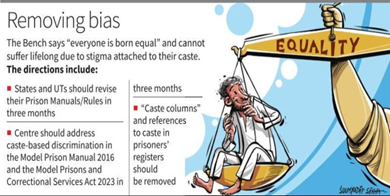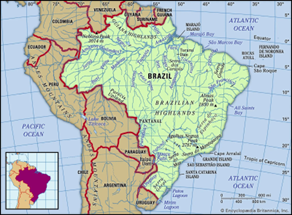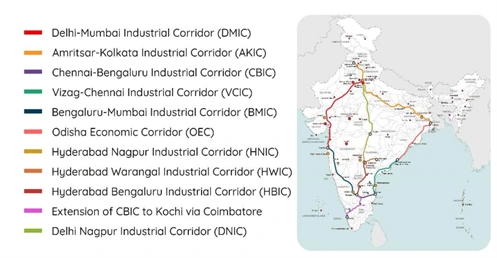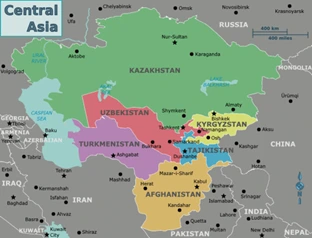Saturday, 5th October 2024
Global Innovation Index 2024
In news: India has recently achieved the 39th position among 133 global economies in the Global Innovation Index 2024, improving from its 40th rank out of 132 economies in 2023.
Global Innovation Index Overview:
- The Global Innovation Index (GII) is a significant benchmark for assessing an economy's innovation ecosystem.
- Published annually by the World Intellectual Property Organization (WIPO), it serves as a crucial tool for policymakers, business leaders, and various stakeholders.
About WIPO:
- The World Intellectual Property Organization (WIPO) functions as a global platform for intellectual property services, policies, information, and collaboration.
- As a self-funding agency of the United Nations, WIPO comprises 193 member states and aims to create a balanced and effective international intellectual property system that promotes innovation and creativity for all.
- Its mandate and operational procedures are defined in the WIPO Convention, established in 1967.
Source: PIB
PM Internship Scheme
In news: The Prime Minister’s Internship Scheme, announced during the Union Budget speech, has been launched to boost youth employability in India.
About the PM Internship Scheme:
- Objective: To provide internships to one crore youth over five years in the top 500 companies.
- Implementation: Managed via an online portal by the Ministry of Corporate Affairs (MCA).
- Stipend: ₹4,500 per month from the central government through DBT, with ₹500 from the company's CSR funds.
- Additional Benefits: Interns receive a one-time ₹6,000 grant and insurance under PM Jeevan Jyoti Bima Yojana and PM Suraksha Bima Yojana.
- Internship Period: One year.
Eligibility criteria:
- Age: 21-24 years.
- Education: Must have passed class 10 or higher, not open to post-graduates.
- Exclusions: Families with government employees, Graduates from IITs, IIMs, IISERs, or those with CA/CMA qualifications and Households with an annual income of ₹8 lakh or more in 2023-24.
Benefits of the scheme:
- For Youth: Provides hands-on training and real-world business exposure.
- For Industry: Builds a pipeline of skilled, work-ready youth for employment in large and small enterprises.
Source: TH
India Joins the International Energy Efficiency Hub
In news: The Union Cabinet, chaired by the Prime Minister, has approved India's membership in the Energy Efficiency Hub, marking a significant step in India's commitment to energy conservation.
About the International Energy Efficiency Hub:
- Purpose: A global platform established in 2020 to promote energy efficiency and foster collaboration among nations.
- Successor to IPEEC: It replaced the International Partnership for Energy Efficiency Cooperation (IPEEC), where India was also a member.
- Members: Currently, 16 countries are part of the Hub, including Argentina, Australia, Brazil, Canada, China, Denmark, the European Commission, France, Germany, Japan, Korea, Luxembourg, Russia, Saudi Arabia, the United States, and the United Kingdom.
- Key Focus: Sharing best practices, knowledge, and innovative solutions among governments, international organisations, and private entities.
India’s Role and Implementation:
- Implementing Agency: The Bureau of Energy Efficiency (BEE) will act as India’s representative in the Hub, coordinating the country's participation and ensuring alignment with national energy efficiency goals.
- The Bureau of Energy Efficiency (BEE) was established in 2002 under the Energy Conservation Act, 2001. Its primary goal is to reduce the energy intensity of the Indian economy by implementing energy efficiency programs and policies.
Significance:
- India will benefit from a global network of experts and resources, enhancing its energy efficiency initiatives.
- India’s participation will support global climate change efforts by advancing energy-efficient technologies and practices.
- The Hub aligns with India's goals for a low-carbon economy and strengthens energy security.
Source: PIB
Tripartite Agreement for Cross-Border Electricity Trade
In news: Nepal, India, and Bangladesh have recently signed a tripartite agreement to facilitate cross-border electricity trade.
Key Details of the Agreement:
- Nations Involved in agreement: Nepal, India, and Bangladesh.
- Nepal will supply surplus electricity to Bangladesh through Indian territory annually from June 15 to November 15. India will handle the logistics of transmitting electricity from Nepal to Bangladesh.
- Nepal will export 40 MW of hydroelectric power to Bangladesh via India in the initial phase, with electricity priced at 6.4 cents per unit.
- Nepal is projected to generate USD 9.2 million annually from this electricity trade, according to the Nepal Electricity Authority (NEA).
Source: IE
Odisha’s leopard population jumps by 22% to 696
In news: Odisha’s leopard population has grown by 22%, rising from 568 to 696 between 2022 and 2024, despite ongoing concerns about poaching and illegal trade in leopard skins.
Key Findings from Odisha Leopard Estimation 2024:
- Leopard Population Growth: Odisha's leopard population increased by 22%, from 568 to 696 in two years.
- Geographical Distribution: Leopards are spread across the state, with 45% found outside protected areas.
- However, the current population is still below the 2018 National Tiger Conservation Authority (NTCA) estimate of 760. In 2022, the population had dropped to 568.
Key Habitats:
- Similipal Tiger Reserve: Hosts the largest leopard population in Odisha and acts as a source population for neighbouring areas like Hadagarh and Kuldiha Wildlife Sanctuaries.
- Satkosia and Hirakud Wildlife Divisions: Satkosia landscape is another significant habitat, boasting the second-highest leopard population, while Hirakud Wildlife Division and Debrigarh Wildlife Sanctuary also support key leopard populations.
Challenges:
- Poaching and Illegal Trade remains a critical issue. Between 2018 and 2023, 59 leopard skins were seized from wildlife smugglers.
- From 2019 to 2024, Odisha's Special Task Force (STF) recovered 57 additional skins.
- In total, 116 leopards were killed and skinned during this period, though experts warn that many illegal skins likely went undetected.
National Leopard Census (India 2022):
- India's total leopard population reached 13,874 in 2022, an 8% increase from 12,852 in 2018.
- Top States for Leopards: Madhya Pradesh: 3,907, Maharashtra: 1,985, Karnataka: 1,879 and Tamil Nadu: 1,070
Leopard Census Methodology:
- Camera Traps: Leopards identified using distinctive rosette patterns through over 85,000 images across 18 states.
- Foot Surveys: Monitoring pug marks, scrapes, and scats to estimate leopard presence.
Significance of Odisha's Efforts:
- Odisha, with 33.5% of its geographical area under forest cover, supports a rich biodiversity across its national park, 19 wildlife sanctuaries, and two conservation reserves.
- The latest estimation and the increased population of leopards signal positive progress for wildlife conservation.
Future Conservation Efforts:
- Beginning next year, the camera trap-based All Odisha Leopard Estimation will be synchronised with the annual All Odisha Tiger Estimation.
- This comprehensive exercise will gather data on both big cat occupancy, prey base estimation, vegetation structure, and human disturbance across the State, ensuring a holistic approach to wildlife conservation.
Source: TH
New Study Mapping the Fruit Fly’s Brain
In news: Scientists have successfully mapped the brain of a fruit fly (Drosophila melanogaster) after a decade-long effort, revealing how 140,000 neurons are interconnected.
About the Fruit Fly Brain:
- The fruit fly's brain is incredibly small, less than 1 mm wide.
- Using a brain map known as a "connectome," researchers traced neuron types to uncover their functions.
- A virtual model of the fly's brain was created based on this connectome.
Key Findings:
- Researchers discovered specific neurons responsible for stopping a walking fly.
- One circuit blocks walking commands, while another stiffens leg joints to halt movement.
Significance of the Study:
- The research provides insights into how sensory information is processed in the brain to trigger actions such as movement.
- It offers a deeper understanding of healthy brain functions and sets the stage for mapping the brains of other species in the future.
Source: IE
U.S. Commission on International Religious Freedom (USCIRF)
In news: India recently rejected a report by the U.S. Commission on International Religious Freedom (USCIRF).
About the report:
- The U.S. Commission on International Religious Freedom (USCIRF) recently released a report highlighting deteriorating religious freedom conditions in India throughout 2024.
- The report cites worsening religious freedom, particularly around India's national elections, and mentions strengthened "discriminatory" laws, such as anti-conversion and anti-terrorism regulations.
- It also focuses on the implementation of the Citizenship (Amendment) Act (CAA) and the passing of a State-level Uniform Civil Code (UCC) Bill in Uttarakhand.
- The report points to hate speech by politicians, including two MLAs, Nitesh Rane and Geeta Jain, as further contributing to religious intolerance.
About USCIRF:
- The USCIRF is an independent, bipartisan U.S. federal agency established under the International Religious Freedom Act (IRFA) of 1998.
- Its primary role is to monitor religious freedom violations globally and make policy recommendations to the U.S. government.
- Composition: The nine Commissioners of USCIRF are appointed by the U.S. President and Congressional leaders. They are supported by a nonpartisan staff.
- Monitoring Standards: The USCIRF uses international standards, including Article 18 of the Universal Declaration of Human Rights, which guarantees the right to freedom of religion. This includes the right to change one's religion, practise it publicly or privately, and express it through teaching, worship, and observance.
Functions of USCIRF:
- The USCIRF reviews religious freedom violations around the world.
- It provides policy recommendations to the President, Secretary of State, and Congress.
- The commission issues an annual report that:
- Evaluates U.S. implementation of IRFA.
- Identifies “Countries of Particular Concern” involved in severe religious freedom abuses.
- Provides an assessment of religious freedom conditions globally.
| Key Principle - Article 18 of the Universal Declaration of Human Rights: "Everyone has the right to freedom of thought, conscience, and religion; this right includes freedom to change his religion or belief, and freedom, either alone or in community with others and in public or private, to manifest his religion or belief in teaching, practice, worship, and observance." |
Source: TH
Classical Language Status in India
In news: The Union Cabinet recently granted classical language status to Marathi, Bengali, Assamese, Pali, and Prakrit, recognizing their ancient literary traditions and cultural significance.
What is a Classical Language?
Classical languages are ancient languages that have independent traditions and rich literary histories, significantly influencing various literary styles and philosophical texts.
History of Classical Language Status:
- The concept of classical languages was introduced by the Indian government in 2004, when Tamil was first recognized.
- Over time, the following languages were conferred classical status: Sanskrit (2005),Kannada (2008), Telugu (2008), Malayalam (2013) and Odia (2014)
Criteria for Classical Language Status: The status is granted based on the following revised criteria, as outlined by the Linguistic Experts Committee (LEC) under Sahitya Akademi (2024):
- High antiquity of the language’s early texts/recorded history spanning 1500-2000 years.
- A significant body of ancient literature or texts regarded as cultural heritage.
- The language must possess a distinct and original literary tradition, not derived from another language community.
- Prose texts and epigraphical/inscriptional evidence, in addition to poetry, must exist.
Benefits of Classical Language Status:
- Cultural Preservation: Encourages the preservation of ancient literary works and manuscripts.
- Academic Research: Facilitates research and digitization of ancient texts, ensuring accessibility for future scholars.
- Recognition and Awareness: Enhances awareness of the language’s contribution to national and global culture, fostering pride among speakers.
- Promotion and Support: The government provides financial support and resources for the promotion of classical languages.
Promotion of Classical Languages:
- The government established three Central Universities in 2020 to promote Sanskrit.
- The Central Institute of Classical Tamil supports research, translation, and courses on ancient Tamil texts. Other Centres for Excellence have been set up for Kannada, Telugu, Malayalam, and Odia under the Central Institute of Indian Languages, Mysuru.
Source: TH
Cabinet Approves PM Rashtriya Krishi Vikas Yojana
In news: The Union Cabinet, chaired by Prime Minister Shri Narendra Modi, approved the rationalisation of two umbrella schemes: Pradhan Mantri Rashtriya Krishi Vikas Yojana (PM-RKVY) and Krishonnati Yojana (KY).
Objectives of rationalisation of schemes:
- PM-RKVY: Focus on promoting sustainable agriculture practices.
- Krishonnati Yojana: Aim to ensure food security and agricultural self-sufficiency.
- Under KY, Mission Organic Value Chain Development for North Eastern Region (MOVCDNER): An additional Detailed Project Report (MOVCDNER -DPR) component has been added to address critical challenges in the region.
Key Highlights:
- Total Expenditure: ₹1,01,321.61 crore, with ₹69,088.98 crore from the central government and ₹32,232.63 crore from the states.
- State Flexibility: States can reallocate funds between components based on specific needs, ensuring better resource utilisation.
- Technological Integration: Both schemes will leverage technology for efficient implementation.
- Focus Areas: Address emerging agricultural challenges like climate resilience, value chain development, nutrition security, and private sector participation.
- Annual Action Plan (AAP): States can submit comprehensive strategic plans instead of individual scheme-wise AAPs.
- This rationalisation aims to avoid duplication, ensure convergence of resources, and allow states to create holistic agricultural strategies that address both productivity and sustainability.
PM-RKVY Components: Soil Health Management, Rainfed Area Development, Agroforestry, Paramparagat Krishi Vikas Yojana, Agricultural Mechanization and Crop Residue Management, Per Drop More Crop, Crop Diversification Programme etc.
Source: PIB
Caste bias, segregation in prisons violate dignity
In News: The Supreme Court recently issued directives to the Centre and states to end caste-based work assignments and housing arrangements in prisons.
Key Directives of the Supreme Court:
- The Supreme Court ordered that jail manuals be revised to eliminate any caste-based segregation and discrimination in work assignments.
- The court emphasised the need for swift action, mandating the completion of this revision within three months.
- It declared these practices unconstitutional, violating inmates' rights to dignity, equality, and non-discrimination.
- This ruling aims to address long-standing caste-based discrimination in India's prisons, mandating prompt reforms across states and Union Territories (UTs).
Background of the Ruling: The verdict originated from a petition filed by a journalist, calling for an overhaul of prison manuals that reinforce caste hierarchies. The petition pointed out that caste bias persists in the division of manual labour and the segregation of barracks among inmates.
Key Points from the Verdict:

- The SC specifically addressed discrimination against marginalised communities, including Scheduled Castes (SC), Scheduled Tribes (ST), and Denotified Tribes (DNTs), in prisons.
- It criticised the treatment of DNTs as "habitual offenders" and denounced caste-based assignments of labour, such as menial tasks (cleaning) for lower castes and cooking roles reserved for higher castes.
- The court ruled that these practices violated: Articles 14 and 15 (equality and non-discrimination), Article 17 (prohibition of untouchability), Article 21 (right to life and dignity) and Article 23 (prohibition of forced labour).
- The SC pointed out gaps in the Model Prison Manual of 2016, which failed to fully eliminate caste-based segregation and criticised it for not incorporating the Prohibition of Employment as Manual Scavengers Act 2013.
Directives to Centre, States, and UTs: The court directed adherence to procedural safeguards laid down in key cases like Arnesh Kumar vs. State of Bihar (2014) and Amanatullah Khan vs. Commissioner of Police, Delhi (2024), with special attention to protecting vulnerable communities from systemic biases.
Fundamental Rights of Prisoners: Article 21 guarantees the right to life and personal liberty and
Article 39A ensures free legal aid for those in need.
Key Challenges in Indian Prisons:
- Overcrowding: Prisons are operating at 117% capacity, primarily due to the high number of under-trial prisoners. Many cases remain unresolved despite the SC's emphasis on the right to a speedy trial under Article 21.
- Unhygienic Conditions: Many prisoners lack proper medical facilities. Female inmates often lack access to adequate health services and sanitary products.
- Custodial Torture: Despite the DK Basu judgment (1986) prohibiting custodial torture, reports of custodial violence and deaths continue to rise.
- Delays in Trials: Prolonged legal processes lead to extended incarceration, affecting prison administration and inmates' well-being.
- Challenges for Women Prisoners: Rising female inmate populations face inadequate facilities and lack dedicated women’s prisons.
- Challenges to Prison Reforms:
- Prisons are a state subject, leading to inconsistencies in prison management. The Union Government can only provide models for states, making it the responsibility of state governments to implement reforms.
- The Prisons Act of 1894, a colonial-era law, treats prisoners as second-class citizens and supports punitive rather than rehabilitative approaches.
- A lack of political motivation exists to reform prisons, as the Representation of People's Act excludes prisoners from voting rights, reducing the incentive for leadership to act.
Prison reforms: Committees and Recommendations:
- Justice Mulla Committee (1983): Proposed an all-India prison cadre, a National Policy on Prisons, and alternatives to imprisonment like community service, improve prison conditions, create the Indian Prisons and Correctional Services, allow public and media visits for transparency and expedite trials to reduce under-trial prisoners.
- Justice V. R. Krishna Iyer Committee (1987): Recommended separate institutions for women offenders and provisions to restore their dignity.
- Justice Amitava Roy Panel (2018): Suggested special fast-track courts for petty crimes, improving the lawyer-prisoner ratio, utilising video-conferencing for trials, and allowing new prisoners a free phone call.
- Provisions of the Model Prisoners Act 2023: The state is responsible for providing free legal aid. Parole allows early release under behavioural conditions, and furlough helps maintain social ties, benefiting inmates' mental health. Facilities for women and transgender prisoners, and the use of technology in prison administration.
Key Case Laws:
- Sunil Batra v. Delhi Administration (1978 & 1983): The Supreme Court affirmed that prisoners retain fundamental rights consistent with their incarceration. It emphasised humane treatment and outlined substantive and procedural rights for prisoners. The Court condemned practices like solitary confinement and degrading labour assignments as violations of liberty and dignity.
- Hussainara Khatoon vs. Home Secretary (1979): Emphasised the right to a speedy trial.
- State of Rajasthan vs. Balchand (1978): Established that bail is the rule, not jail.
- DK Basu v. State of West Bengal (1997): The ruling emphasised that arrest information must be communicated to a relative or friend immediately to ensure legal representation and preparation for defence.
- Re Inhuman Conditions in 1382 Prisons (2016): This landmark ruling highlighted the need for reforms, ensuring prisoners' dignity and rights, leading to the Model Prison Manual 2016's establishment of the Under-trial Review Committee.
Future Approach to Prison Reforms:
- Focus on alternatives to incarceration to alleviate overcrowding, such as releasing elderly or sick inmates, lowering penalties, and expediting the trial process.
- Implement a bail law to make bail provisions more objective, minimising the subjectivity of lower courts.
Source: TH
Why Italy matters to India
In news: Antonio Bartoli, Ambassador of Italy visited India recently to discuss bilateral cooperation and security ties.
About the context:
- In the era of global challenges or "polycrisis," India and Italy converge their interests in the Indo-Mediterranean Sea region, which is an important place for global trade and digital connectivity.
- Italy is the world's sixth largest exporter and is extra specially interested in restoring stability to the region.
- Some issues do indeed warrant Italy and India cooperating with each other, such as piracy, Gaza and Lebanon, and the Russia-Ukraine war with implications on trade.
Shared Interests of Italy and India in the Indo-Mediterranean Region:
- Italy and India have common strategic interests promoting security and prosperity in the Indo-Mediterranean region that are important for international trade and digital connectivity.
- This is to be stated despite the incoming Blue-Raman submarine data cables between Genoa and Mumbai, again reiterating the same importance.
- Both countries have piracy in the Red Sea, as well as the continuing Gaza and Lebanon conflicts, and the Russia-Ukraine war affects agricultural and oil trades.
Security and Naval Presence of Italy in the Area: Italy has been increasingly integrated into the Indian Ocean Region (IOR) and West Asia through:
- Joining the Group of Friends of UNCLOS in 2021.
- Acquiring the status as the second largest contributor to the EU Naval Force (EU NAVFOR) and the European Maritime Awareness in the Strait of Hormuz (EMASoH).
- Its objective, EUNAVFOR ASPIDES, which Italy had chaired since February 2024 and which aimed to be able to provide the guarantee of freedom of navigation in the Red Sea, Indian Ocean, and the Gulf.
Key Attributes of Defence Relations Between Italy and India:
- The agreement signed last October 2023 expands the areas for cooperation in the area of defence research, industrial cooperation, maritime awareness, and environmental activities in military operations.
- The Italy-India Military Cooperation Group was held in March 2023. It was an example of such improvement in coordination and planning on the issues of defence.
- Other examples of collaborative defence-related interactions between Italian and Indian companies are the collaborations of Italian defence companies with Indian firms, especially to assist India's Make in India program. Notable Italian defence companies are Fincantieri and Leonardo, which feature among the top 50 arms producers. Examples include Fincantieri collaborating with Cochin Shipyard from 2020.
- Italy is also conducting joint exercises (PASSEX) and hosting workshops on defence industrial cooperation with the naval visits.
- In 2019, Elettronica signed a Memorandum of Understanding with Bharat Electronics Limited to support the development of cooperation in Defence Technology
Cooperation in Indian Ocean Region and Africa:
- Italy and India are strong advocates for African development and integration at international platforms. Italy and India together have pursued the inclusion of the African Union in the G20.
- The Mattei Plan of Italy includes the Africa investment program worth €5.5 billion, collaborative partnership development to be first focused on Egypt, Ethiopia, Kenya, and Mozambique—countries in the Indo-Mediterranean world.
- Italy will also support the India-Middle East-Europe Economic Corridor, which will help in sustaining long-term economic growth through infrastructure development of railways, ports, and logistics systems.
- Italy views the future of IMEC as having a lot of depth for stability and prosperity in Europe, West Asia, and India, more so at a time when the whole region is facing troubled waters.
People-to-People Relations Between Italy and India:
- The country has the second-largest number of Indian diaspora residing in the European Union, which also shows that people-to-people ties between the two countries are really robust.
- These relations are based upon historical cultural exchange flows and have grown further in recent times through economic, cultural, and educational relationships .
- These ties form the backbone of a strong Italy-India tie that strengthens the overall diplomatic and strategic interactions between the two nations.
Future prospects to strengthen India-Italy ties:
- Strengthen trade ties, explore new investment opportunities, and promote economic cooperation.
- Reinforcing EU-India Relations would lead to the development of bilateral trade from India to Italy as part of a larger EU-India partnership.
- Team up in the global field to formulate a common agenda of the world.
Source: TH
Share the article
Get Latest Updates on Offers, Event dates, and free Mentorship sessions.

Get in touch with our Expert Academic Counsellors 👋
FAQs
UPSC Daily Current Affairs focuses on learning current events on a daily basis. An aspirant needs to study regular and updated information about current events, news, and relevant topics that are important for UPSC aspirants. It covers national and international affairs, government policies, socio-economic issues, science and technology advancements, and more.
UPSC Daily Current Affairs provides aspirants with a concise and comprehensive overview of the latest happenings and developments across various fields. It helps aspirants stay updated with current affairs and provides them with valuable insights and analysis, which are essential for answering questions in the UPSC examinations. It enhances their knowledge, analytical skills, and ability to connect current affairs with the UPSC syllabus.
UPSC Daily Current Affairs covers a wide range of topics, including politics, economics, science and technology, environment, social issues, governance, international relations, and more. It offers news summaries, in-depth analyses, editorials, opinion pieces, and relevant study materials. It also provides practice questions and quizzes to help aspirants test their understanding of current affairs.
Edukemy's UPSC Daily Current Affairs can be accessed through:
- UPSC Daily Current Affairs can be accessed through Current Affairs tab at the top of the Main Page of Edukemy.
- Edukemy Mobile app: The Daily Current Affairs can also be access through Edukemy Mobile App.
- Social media: Follow Edukemy’s official social media accounts or pages that provide UPSC Daily Current Affairs updates, including Facebook, Twitter, or Telegram channels.





